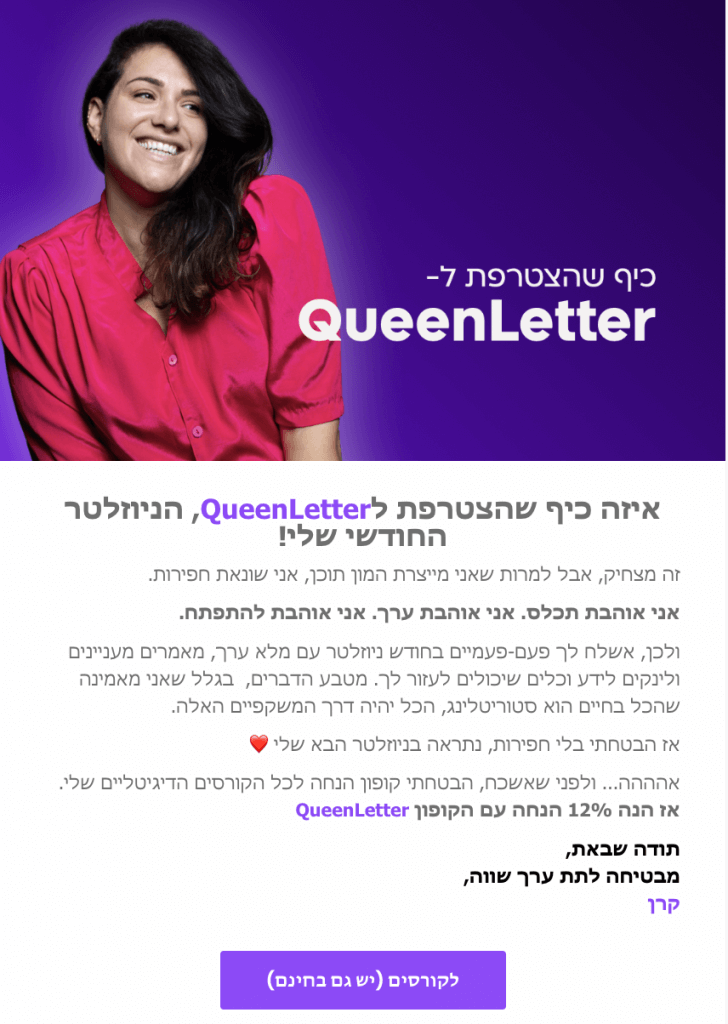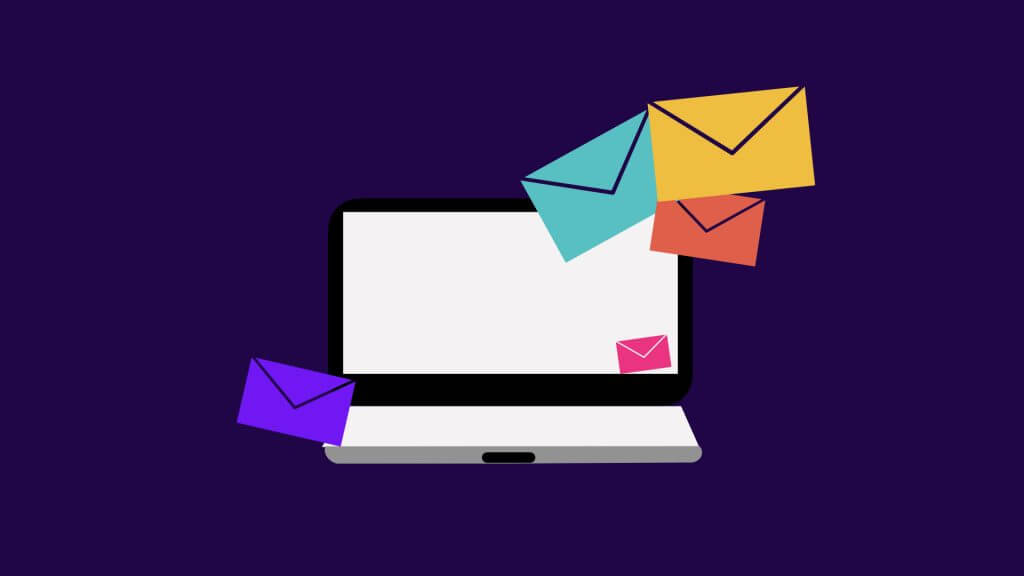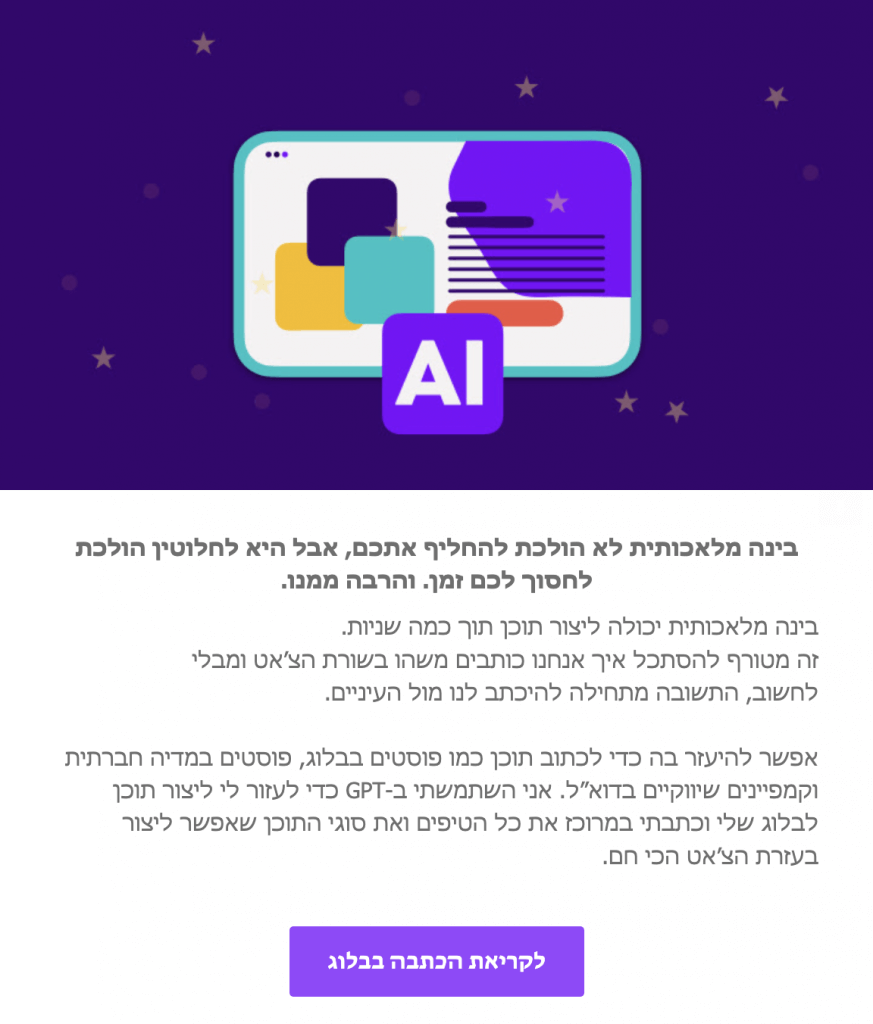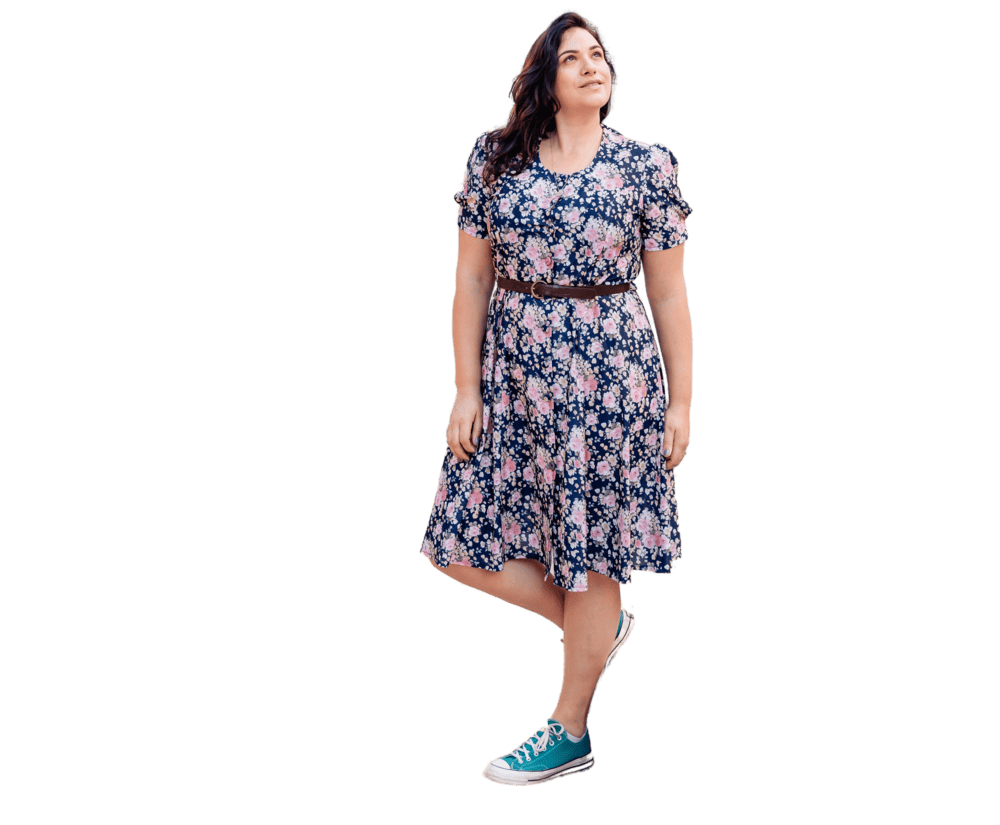Where to start with email marketing?

The most powerful asset for your brand can be a strong distribution list that keeps you in the awareness of your audience and also encourages purchases.
Here’s what you need to know about different types of emails and when to use them.
If we take a post you made a year ago that received 100 likes, today that same post will receive about 20.
The algorithm’s exposure is significantly decreasing as social networks seek profitability and lead us to pay for exposure through paid marketing.
As someone who believes in slow but steady brand building, I cannot ignore that time and time again they pull the rug from under us and change the algorithm. Now there’s more exposure to reels and videos, and tomorrow they’ll decide our content needs to be in 3D. It’s frustrating.
As business owners, we must create a channel that we control. If you’ve been thinking about email distribution lists, you’re absolutely right.
So how do we build relationships and create engagement that leads to conversions with email marketing?! Keep watching.
If you’re thinking there’s a lot of email that never even reaches you, you’re right. It’s definitely getting harder to land in the primary inbox of our potential customers.
But still, it’s one of the most powerful tools to communicate with your following audience, past customers, and potential customers.
Optinmonster published an article titled: 40+ Email Marketing Statistics You Need to Know for 2023
It’s clear, even in 2023, email marketing remains one of the most important tools. Let me convince you.
According to the article, 92% of people over the age of 18 use emails, with 61% of them checking their email every day. More than half of active users worldwide, 58%, check their email before checking their social networks. Now, success rates are higher if you’re B2B rather than B2C, but still the numbers are high and indicate high conversion rates and increased authority through audience newsletters.
So in case you had doubts, email marketing is still very important for business owners today and it’s still the best way to consistently grow your brand and establish your authority.
Creating good and strategic content through emails ensures staying in the minds of your customers, even if they only read the subject line and remember that you exist. And in general, if we’ve done a good job and written an eye-catching subject, with just a small click, we can make our audience see what we want them to see.
How many times have you launched a new product but the algorithm gods haven’t even exposed your post to enough people? We’re putting an end to that, with everything you need to know about the types of emails you should start sending to your audience today.
#1 Confirmation Email

This is an automated email sent to those who have signed up for your newsletter or downloaded a guide. In fact, every registration of a new person to one of your lists requires such an email.
It can be a single email, one that provides confirmation and a pleasant message, or a sequence of emails sent in automation one after the other.
For example, someone who signs up for my historical newsletter, also known as QueenLetter, receives a brief confirmation email that explains what content and value they will receive from my newsletter and how often they can expect it.
When crafting your “Welcome” email, you want this email to reflect the character of your brand and make your subscribers feel welcomed, valued, and important.
After signing up for a guide or a free gift, I would recommend creating an automation of email series whose goal is to introduce your brand more deeply. I assume that someone who subscribes to a newsletter wants to receive more emails from you, so you’ll have an opportunity to create a deeper relationship system.
With a free gift, on the other hand, those who sign up expect to receive that same gift, and that’s it.
So here too, there needs to be an experience email accompanying the sign-up along with the gift. A short email whose sole purpose is to provide the gift. At this stage, they might part ways with you, and that’s okay.
The following emails in the series will attempt to build trust and drive action.
So you need to decide what action you want them to take. Whether to purchase from you, reach out to you, or read something.
You need to remember that to break someone down for a purchase, it takes time.
So my recommendation is to send an introductory email about who you are, because even though they signed up to receive a free gift from you, not everyone knows who you are. Then, an email with free value that connects to the gift they received. And then a proposal email – to continue following, watching, purchasing. It’s up to you to decide.
The clear goal of this type of email is to provide value to your list on autopilot while providing an unforgettable brand experience.
#2 Building Trust and Awareness Over Time
The goal of these emails is to create awareness of the solution you offer, while connecting to the pain and need of your audience. This means you have a short window of time to help those who joined your mailing lists feel like they are part of something bigger. That they have come to a place where they can get answers to their questions. That they can trust you to provide them with the information they need.
It’s time to make your followers trust and believe in your actions and the solution you offer.
Remember, we always want to nurture the relationship with our audience and encourage engagement. Ultimately, if we look at the big picture, being in the audience’s awareness and turning them into ambassadors for your brand is the most important thing we can do.
An idea for an email series to your distribution list could be:
Email #1
A warm welcome to your brand and identification with where you are in your journey, regarding your brand. For example, for me, it’s identifying with the confusion and lack of ability to find the right story for the brand and create a strong brand base.
Email #2
Personal introduction to your brand’s personal mission. A bit about who you are, why you started your brand, and what the purpose of your existence is.
I really love writing the mission statement because in my opinion, it really helps to understand what I’m doing and why.
Email #3
Adding amazing and new value that your followers will be happy to receive and will be happy to use your solution. In other words, if you have a small course, a 1:1 meeting, or something you want to offer, after the real and generous value you’ve given – this is the time.
#3 Bringing Back the Lost Ones

If you have courses on your site or a product that can be automatically checked out, you’re probably familiar with the scenario where you look at your store’s data and performance and discover that many people have abandoned the checkout. It happens all the time.
Therefore, the third type of mailing is “Cart Abandonment Recovery”.
This is an email sent only to those who have items in their cart but didn’t purchase, instead leaving it behind. Typically, the email is a short reminder and not an aggressive pitch reminding the abandoner that they forgot to complete their purchase. It’s just a gentle reminder with a link back to where the potential customer was.
You can add a small discount to encourage the purchase, remind them of any bonuses or benefits they’ll receive with the purchase of the product or service, or even offer an alternative to the purchase.
The offer in the email should be time-limited and attempt to encourage the email recipient to act now.
#4 I Have Something to Offer (Through Mailing Lists)
Sales Email.
Here lies the big money. We’ll send an offer to our followers, hoping they’ll be intrigued, read, and maybe, if we’re lucky, purchase.
The number of emails included in the sales journey will vary depending on the business’s product, ultimately ending with the campaign. A one-time offer email, or teasers and time-limited deals, can be sent.
In my opinion, a good sales campaign consists of somewhere between 6 to 10 emails for the launch of a new product or service.
We’ll want to send an email stating when the product or service will be available and showcase the product. Another email will describe the benefits and how it helps potential customers.
If there was any trial with the product or service, we can add digital testimonials to support and add credibility.
The next email will tell a story or event that occurred and how your product or service helped an outsider to help overcome objections from potential customers and encourage them to purchase.
The final email will tell your customers that this is the last chance to purchase on sale/discount/early bird purchase and describe what will happen if they continue to procrastinate with their decision to register.
What I’ve described now is the main structure. It can be extended and more case studies, stories, reasons, lists, checklists can be sprinkled to make the journey longer.
#5 Good Morning, I’m Still Here (On Mailing Lists)
Emails that wake up the dormant audience.
It’s clear you’ve subscribed to some newsletter before, but then you stopped reading it. Life went on, and suddenly you noticed they stopped emailing you.
Sometimes, emailing an audience that doesn’t open the emails is more harmful than helpful.
The goal of this email is to catch the attention of the audience. We’re essentially pushing the dormant ones to wake up and start creating renewed engagement with our content.
This can be done in several ways.
What I’ve tried and worked well for me is offering a free gift and just adding value in the hope that it reminds my subscribers why they signed up for my newsletter in the first place.
The second type is to connect with the real value for which you believe your audience signed up for your mailing. “Still looking for ways to improve your story?” The words “your story” are the reason, the benefit. You can replace this with any other clear benefit of your service. Remember, you want them to open the email. That’s the goal – to bring you back to their consciousness.
#6 Value, Value, and Value

This is the beloved and familiar newsletter.
When someone subscribes to your list, they expect to start receiving newsletters from you to see if your promise was worth it. It’s a very important process of building trust and rapport between your brand and the audience. If you sell something online, it’s important to create a delicate balance of sales and a lot of value. You don’t want your audience to feel like you’re constantly selling to them.
At the most basic level, there should always be some kind of hook, teaser, and call to action.
I send an email every other Sunday (twice a month) when a new episode of my podcast “Between Worlds” is released.
The hook of my email or subject line usually depends on the topic of the episode, to encourage the audience to engage.
In the body of the email, there’s a teaser that tells a bit more about the benefits of the episode and its purpose to spark curiosity.
And then of course, there’s a call to action, to get to the episode. I always try to provide written value or a YouTube video that provides an additional perspective or deepens the knowledge of what we talked about in the episode.
A few important things to know about mailing lists:
- You didn’t invent and won’t reinvent the wheel.
All email journeys are either online or you received them to your email from some brand.
Therefore, I recommend:
- Creating an inspiration folder in your email where you keep emails you liked and received from brands you trust and love their content. Of course, you won’t copy the content, but you can use the structure and get inspired on how they address their audience.
- There are websites like encharge.io where there are a lot of series of emails and excellent examples, in English of course. The only thing I would be careful about is not to use the emails as they are, because as you know, you’re not the only one using content from there. Even though we’re in small Israel.
- Managing your mailing lists must be done according to segments. The idea is to manage lists within your mailing list. So you’ll know what each person was interested in and be able to email them only the information that suits them.
Let me give you an example:Let’s say you’re fitness trainers and you have a postpartum women’s training course and a course for techies.
In the past, you’ve promoted a free value both to postpartum women and to techies and busy people.
There’s no problem sending your newsletter to everyone.It may be that you want to offer the techies’ training course to everyone. But when you want to send registration for the postpartum women’s course, you’ll only want to email women who were interested in that specific course. The same goes if you want to give tips to postpartum women.
- Creating segments allows you to offer different products exactly to the audience that is interested in them. You wouldn’t want to bore your audience with content that doesn’t interest them.
Start anyway.
It doesn’t have to be perfect. Learn along the way. But start emailing your audience. It’s the best way to build trust and a relationship with your audience over time and without relying on social media.







